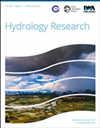Hydrological effects of open ditch damming and controlled subsurface drainage in a Nordic agricultural field
IF 2.4
4区 环境科学与生态学
Q2 Environmental Science
引用次数: 0
Abstract
Controlled drainage (CRD) is an agricultural water management practice designed to adjust the capacity of a drainage system under varying hydrological conditions. This simulation study aimed to quantify the potential of combining a controlled subsurface drainage (CS) with open ditch damming (CD) to manage the water table depth (WTD) and field water balance in Nordic conditions. Simulations with and without controlled drainage were run using a hydrological model that had been set up for a flat loamy field in Northern Ostrobothnia, Finland, for the period 2010–2021. All CRD scenarios reduced the probability of deep WTDs during growing seasons (May–Sep). The impact of CS on WTDs was greater and more uniform than CD. The CRD effects on water balance were seen in water outflow pathways, as CS reduced drain discharge while CD had the opposite effect. When both methods were applied simultaneously, annual evapotranspiration increased 5–12% compared with the free drainage scenario. The effects of CRD on evapotranspiration were greatest during the dry years indicating that CRD has potential to reduce drought in food production areas. None of the CRD scenarios could maintain optimal WTDs during the entire growing season, highlighting the complexity of optimizing field water management using CRD alone.北欧农田明沟筑坝和受控地下排水的水文影响
控制排水(CRD)是一种农业用水管理方法,旨在不同水文条件下调整排水系统的容量。本模拟研究旨在量化将控制性地下排水(CS)与开沟筑坝(CD)相结合的潜力,以管理北欧条件下的地下水位深度(WTD)和田间水平衡。在 2010-2021 年期间,利用为芬兰北奥斯特罗布尼亚的一块平壤土田建立的水文模型,对有控制排水和无控制排水进行了模拟。所有控制排水方案都降低了生长季节(5 月至 9 月)出现深度 WTD 的概率。与CD相比,CS对WTD的影响更大且更均匀。CRD 对水平衡的影响体现在出水途径上,CS 减少了排水量,而 CD 则产生了相反的影响。当两种方法同时应用时,与自由排水方案相比,年蒸散量增加了 5-12%。在干旱年份,中水回灌对蒸散量的影响最大,这表明中水回灌具有减少粮食生产地区干旱的潜力。没有一个 CRD 方案能在整个生长季节保持最佳 WTD,这凸显了仅使用 CRD 优化田间水管理的复杂性。
本文章由计算机程序翻译,如有差异,请以英文原文为准。
求助全文
约1分钟内获得全文
求助全文
来源期刊

Hydrology Research
Environmental Science-Water Science and Technology
CiteScore
5.30
自引率
7.40%
发文量
70
审稿时长
17 weeks
期刊介绍:
Hydrology Research provides international coverage on all aspects of hydrology in its widest sense, and welcomes the submission of papers from across the subject. While emphasis is placed on studies of the hydrological cycle, the Journal also covers the physics and chemistry of water. Hydrology Research is intended to be a link between basic hydrological research and the practical application of scientific results within the broad field of water management.
 求助内容:
求助内容: 应助结果提醒方式:
应助结果提醒方式:


